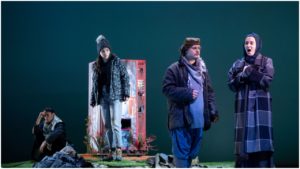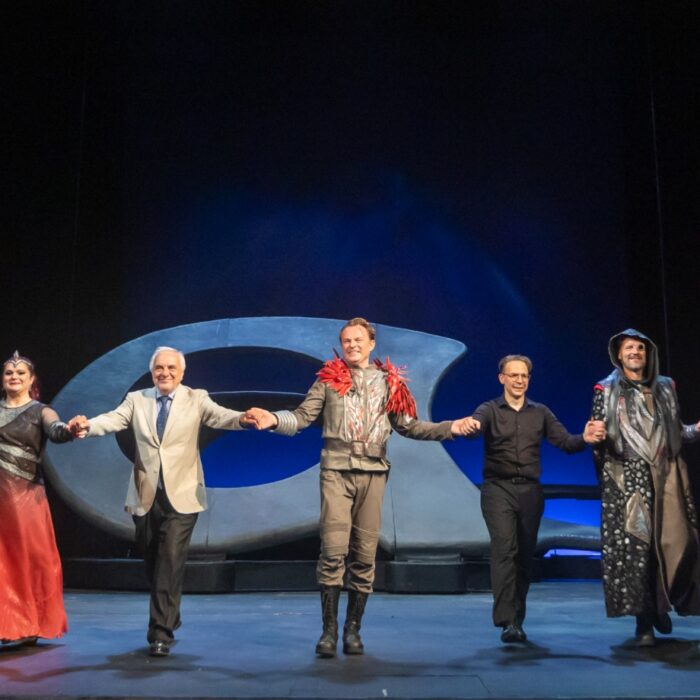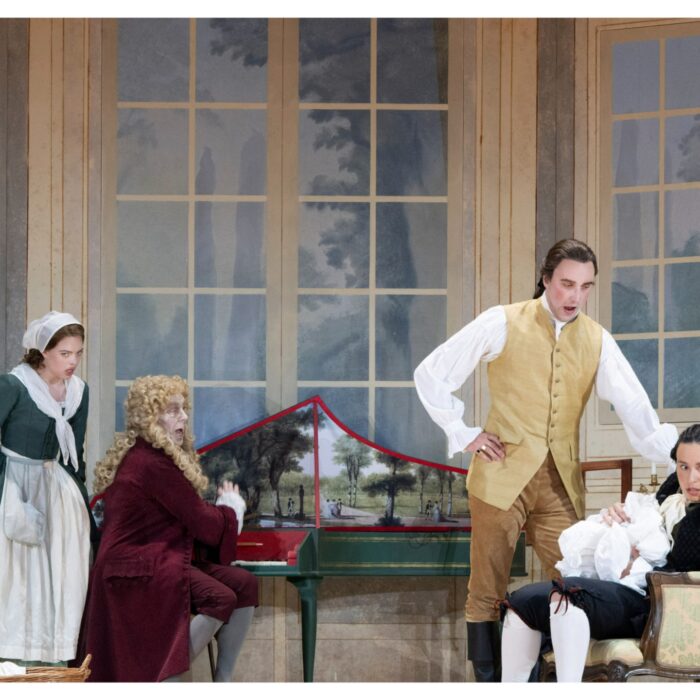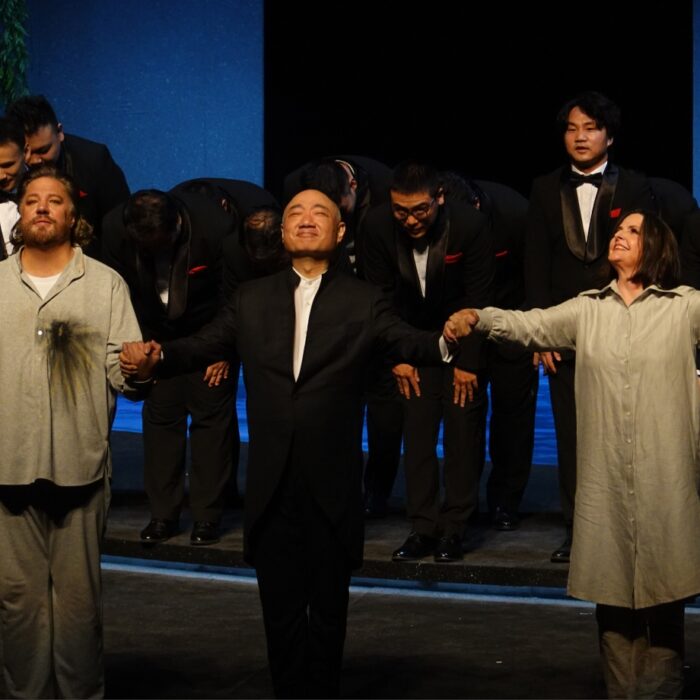
Teatro Comunale Pavarotti-Freni Modena 2021 – 2022 Review: ‘Sogno,’ ‘Fuga In Egitto’ & ‘E Tu, Che Sai Tu Del Futuro?’
Three Operas Explore the Refugee Crisis In Europe to Mixed Results
By Alan Neilson(Photo: Rolando Paolo Guerzoni)
Agitprop is a miserable form of theatre. The creators approach a potential work with a rigid set of ideas they believe it is their duty to convey to a welcoming and grateful public that will reinforce those said values or, even more excitingly, to an audience that is in need of education and enlightenment.
Unfortunately, the underlying ideas that carry the work tend to be far less insightful than the creators believe them to be, often promoting the message at the expense of the drama, and compromising what might have been a promising composition. When the State involves itself in such a project, then we move into more murky waters, for we must consider the extent to which it is promoting its own agenda; do artists and audiences really want to have their theatrical performances validated and circumscribed by higher authorities?
A Transnational Collaboration: 3 Operas from 3 Countries
Such concerns came to the fore with Modena’s “Crossopera” project, a collaborative undertaking with Linz’s Landestheater and the Serbian National Theatre Novi Sad. Funded by the European Commission’s European Creativity Program, it brings together artists from Italy, Austria and Serbia for the creation of three short operas that explore “otherness, fear, and discovery.” The theme fits nicely with the aims of the funding body, which took a full page in the program to outline its objectives.
Each of the three operas develop a story concerning the recent wave of immigration into the European Union. This aligns with the project’s aim of promoting “cultural expression… …facilitating the integration of refugees.” Whatever one’s opinions, it is certainly a contentious and important subject, one which the arts have a duty to explore. The problem that can arise, however, is in balancing the dramatic and musical quality of the works with their political underpinnings. A work that sets out to prioritizes an uncompromising political stance, no matter how noble or well-intentioned, is likely to leave an audience cold. If, however, the political message is embedded within a well-constructed drama, it may well prove to be successful.
Each opera was written by a composer from one of the three countries involved, to a text in their native language. The cast was comprised of six singers, two from each country, while Djordje Pavlović conducted the Ensemble dei Teatri di Modena, Linz, Novi Sad, which also contained musicians from all three countries. The director Gregor Horres, along with scenographer and costume designer Mariangela Mazzeo, video designers Hanna Hildebrand and Marcello Rotondella and the lighting designer Marcello Marchi were responsible for the staging of all three operas.
The resulting productions were very different, not only in the way they tackled the subject, but also in the degree to which they were successfully able to convey their political messages, whilst delivering a dramatically sharp and engaging narrative.
Sogno (The Dream) by Composer and Librettist Jasmina Mitrušić
Lasting a little short of 30 minutes “Sogno” tells the story of two Syrian refugees, a mother and her daughter, who find themselves waiting at a bus stop in a deserted wasteland in Southern Serbia. They are being helped by Ana, a worker from a refugee centre. Exhausted and missing their homeland and family, they rest on bench and wait for the bus. Three male Afghan refugees, who are fleeing from the violence in their homeland, arrive. They are also tired, and have suffered many depredations. While they wait, they all fall asleep and into a collective dream, and all the barriers that separate them fall away. They awake with a deeper understanding of the “other,” and continue on their journey with renewed confidence.
This was by far the most accomplished of the three works. It possess a strong narrative in which the suffering of the refugees was clearly presented. Their exhaustion and fear, their sense of dislocation and reliance on Ana, and their nostalgia for their homeland and the families they have left behind, and of course the desperate physical conditions in which they now find themselves in were all expertly conveyed. It was a very intimate portrait, one that is easy for the audience to sympathize with. The dream sequence that rallies their resolve to continue their journey was a neatly conceived metaphor for the support and strength they find in each other. It also allowed the opera’s underlying message to develop naturally from the drama.
Horres’ effective staging was functional, engaging and evocative, and each of the six characters was strongly defined. The desolate stage was dominated by a broken, unkept vending machine, which had been left to rot. The bus stop stood alone, with a small bench to one side. It was a miserable, lonely place, not somewhere anyone would want to spend time. The dream sequence was excellently supported by Hildebrand and Rotondella’s colorful video sequence of the heavens, projected on to the back wall, and Marchi’s lighting created an engaging ambience that managed to both magnify the desolation of the scene and the warmth of the characters simultaneously.
Mazzeo’s costumes were perfectly matched to the situation, with the refugees in heavy Eastern clothes, disheveled and dirty, while Ana was dressed in Western clothes of only slightly better quality.
Mitrušić’s imaginative libretto was equalled by her wonderful score, which was neatly aligned to the dramatic movement of the narrative, and successfully captured the confused feelings of the refugees, while highlighting their shared sense of hope and solidarity in the final scene. The warm, sometimes thin, textures occasionally conjured up a sentimental feel and emphasized their humanity and melancholy, while the disjointed rhythms and constant discordant interruptions to the melody by individual instrument created a sense of dislocation and anxiety. It was all cleverly managed, and moreover, it proved to be an engaging and interesting score in its own right.
All the singers produced strong performances, with contralto Dalila Djenic particularly noteworthy in the role of the mother Maria. She successfully captured her character’s exhaustion, nostalgic longings and fears with an expressive performance in which her pain could be heard etched into her voice.
Soprano Evgenija Jeremić, cast as her daughter Sara, forged a convincingly strong and believable relationship with Djenic. Her presentation was emotionally expressive and she displayed considerable stamina and agility in the upper register as she pushed the voice upwards, giving it a sharp, hard edge to highlight her anxieties.
Mezzo-soprano Idil Karabulut produced a sympathetic reading of Ana, the worker from the refugee centre.
The Afghan refugee Adnan was played by bass Strahinja Dokić, whose physically imposing frame, magnified by his free flowing robes and turban gave him an authoritative air, and made him appear to be the leader of the small group of men. His rich, warm timbre was used expressively to develop his character, although his vibrato may have been too strong on certain occasions for certain tastes.
Tenor Florian Wugk gave a passionate, energetic and expressive performance as the young Afghan refugee Osman, successfully portraying the mental trauma he was experiencing as a result of the violence he had suffered while traveling through Pakistan.
Baritone Eugenio Maria Degiacomi gave an emotionally strong presentation as Hasan, with his well-presented monologue showing off his skill in developing the vocal line.
The narrator Sandro Cappelletto appears in all three works, providing background and commenting on the drama. In “Sogno” his narration, to a guitar accompaniment, was clearly presented and with sufficient distant for him to remain distinct from the drama.
Fuga in Egitto (Escape to Egypt) by Composer Valentin Ruckebier & Librettist Hermann Schneider
A family is forced to flee its homeland after the government instigates plans to kill all children under two years of age. Having crossed the dessert, guided by dragons, they find themselves in a hospital in Egypt, and although the staff are trying desperately to help the family, communication problems become such a barrier that it ends with father of the family attacking the staff and having to be restrained in a straightjacket.
The work lasting approximately 35 minutes is harrowing account of the psychological trauma experienced by the family following their escape, which is reflected in the anxious, harsh, disjointed musical textures and rhythms of Ruckebier’s uncompromising and unsettled score, often forcing the singers to the edge of their comfort zones. As such, it is certainly an honest presentation, although one that makes for difficult listening.
Visually, the staging was no less easy for the audience. Mazzeo’s set, consisting of white walls, the doctor’s desk and a glass door, was cold and unwelcoming and gave the appearance of asylum as much as a hospital. Hildebrand and Rotondella’s videos along with Marchi’s lighting were again successful in defining the ambience, and in reflecting the psychology of the refugees.
Schneider’s libretto was in a number of languages, highlighting the degree to which communication difficulties sow the seeds for misunderstanding, frustration and conflict. Horres’ excellent direction magnified the fact through his sympathetic portrayal of all the characters, who for no fault of their own are thrown into conflict with each other.
The title’s allusion to the biblical story is, of course, obvious and deliberate. Whilst this worked well as a connection to past atrocities, as well as a story that resonates with our Christian tradition, the underlying suggestion that the child is some sort of Messiah, or a redeemer is less convincing, and appeared forced; it even tainted the work with an ill-suited sentimentality.
The singers again produced strong performances with Degiacomi’s interpretation of the Father standing out as an expressive portrait of man on the edge. Frightened, frustrated, anxious, stressed, worried, clearly in a state of trauma and unable to communicate his thoughts effectively, he eventually loses control and attacks an assistant.
Jeremić’s cutting soprano was again put to good effect as she gave voice to the mother’s anxieties, her declamation of the text with emotional intensity impressing.
The child, who was positioned at the side of the orchestra pit, was played by Djenic, whose vocal contributions were confined to wordless disjointed sounds as she watched on.
The doctor was played by Dokic, whose characterization was professional, aloof, authoritative, concerned although a little skeptical about the story he was being told by the father.
Karabulut as the nurse and Wugk as the doctor’s assistant both created clearly defined characters.
Overall, “Fuga in Egitto” was a successful exploration of the project’s theme of “otherness, fear and discovery.” It was also well-balanced, so that the drama was never subservient to the message. It was a strong piece of theatre, but not one that was comfortable to listen to or to watch.
E Tu, Che Sai Tu Del Futuro? (And you, what do you know about the future?) by Composer Luigi Cinque & Librettist Sandro Cappelletto
Six refugees confront the reality of today’s world having journeyed to Europe across the Mediterranean Sea. The work does not possess a narrative as such, rather it is a reflection on the errors of the past, and the problems it has caused for people living today. It also forwards principles, founded upon equality, which will allow society to move forward.
This was a piece of agitprop theatre writ large. In fact, there was hardly any drama to speak of at all. Rather the audience was subjected to a critique of how the West, through its colonialism, racism, and European fascism, has caused all the social and environmental problems in the world today, before concluding that the solution is to embrace Utopian ideals, based on equality.
Although Cappelletto was clearly impressed with his own insight, in which he accorded himself a starring role as the narrator who not only opens the work, but steps forward centre stage to bring it to a conclusion, its message provided little beyond the usual tropes which we hear on a daily basis, such as “heroes make peace,” along with other platitudes. In fact, such was Cappelletto’s enthusiasm for his ideas that his narration was far more animated than it was in the other two operas, and he even went so far as to pick up a megaphone. His political message was tedious and dwarfed what little dramatic content was on offer.
Musically, however, this was an impressive work. Cinque created an easily accessible score, touching on various genres, including dance and hints of minimalism. It was rhythmically strong, with pleasing melodies and used a variety of textures, shifting readily from individual orchestral sections to the whole ensemble. There was little for the individual voice, the vast majority of the vocal music being for the small choral ensemble, comprising the six singers, who combined in different parts to create an engaging array of harmonies.
Horres and his team did their best to bring this plotless work to life, and did a fairly good job. The stage was littered with junk, a reference to the Wests’ consumerism and waste, from which the cast emerged during the opening scene, giving them the appearance of homeless refugees. Videos were used to display some of the problems which are now afflicting the world. The cast were painted blue and dressed identically so as to obscure any reference to race, nationality or gender, although having the males grouped on the left side and females on the right side of the stage on occasions somewhat undermined this statement. As there was little in the way of solo parts for the singers, there was no such thing as a character, so interactions tended to be restricted to stylized movements, the purpose of which appeared simply to have something happening on the stage or to please the eye.
At the final curtain, it felt as if one had been at political rally. Notwithstanding Cinque’s fine score, the pleasing singing of the cast or the efforts of the director and his team, the sloganeering, haranguing, and constant lecturing from Cappelletto left one exhausted and ultimately disappointed.
To obtain funding from the European Creativity Program a project must meet its objectives, which “Crossopera” certainly did. Fortunately, in two of the cases, “Sogno” and “Fuga in Egitto” the artist managed to successfully subsume the objectives into the pieces without compromising their dramatic integrity. In “E tu, che sai tu del futro?” this certainly was not the case, and the politics crushed any artistic merit that may have otherwise existed, confirming the opinion that Agitprop theatre usually makes for poor theatre.



